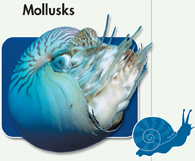| INVERTEBRATE | PHYLUM | DESCRIPTION |
|---|---|---|
| The phylum Mollusca includes snails, slugs, clams, squids, and octopi. |
Mollusks are soft-bodied animals that typically have an internal or external shell. Like annelids, mollusks have true coeloms surrounded by mesoderm. They also have complex organ systems. Why are animals as different-looking as snails, clams, and squid in the same phylum? One answer lies in the behavior of their larvae (singular: larva), or immature stages. Many mollusks have a free-swimming larval stage called a trochophore (TRAHK oh fawr). The trochophore is also characteristic of many annelids, indicating that annelids and mollusks are closely related. |
|
The phylum Echinodermata (ee KY noh durm aht uh) includes sea stars, sea urchins, and sand dollars, all of which live only in the sea. Echino- means “spiny” in Greek, and dermis means “skin” in Latin. |
Echinoderms have spiny skin and an internal skeleton. They also have a water vascular system—a network of water-filled tubes that include suction-cuplike structures called tube feet, which are used for walking and for gripping prey. Most adult echinoderms exhibit five-part radial symmetry. The skin of an echinoderm is stretched over an internal skeleton of calcium carbonate plates. Although radial symmetry is characteristic of simpler animals such as cnidarians, echinoderms are more closely related to humans and other chordates because they are deuterostomes. |
26.1 Assessment

-
Review What was the Cambrian Explosion?
Explain When does fossil evidence indicate that the first animals evolved?
Relate Cause and Effect What two characteristics of early animals explain the scarcity of animal fossils older than the Cambrian Period?
-
Review What is a cladogram?
Explain What does the cladogram of invertebrates show?
Sequence Which body plan feature evolved first—radial symmetry or deuterostome development?
VISUAL THINKING
Design a “new” invertebrate. Create an illustration on which you point out its body plan features. Then, show its place on the cladogram of invertebrates, and write a caption explaining how its features helped you decide where it belongs.

Table of Contents
- Formulas and Equations
- Applying Formulas and Equations
- Mean, Median, and Mode
- Estimation
- Using Measurements in Calculations
- Effects of Measurement Errors
- Accuracy
- Precision
- Comparing Accuracy and Precision
- Significant Figures
- Calculating With Significant Figures
- Scientific Notation
- Calculating With Scientific Notation
- Dimensional Analysis
- Applying Dimensional Analysis






 DOL•42–DOL•43
DOL•42–DOL•43
 DOL•44–DOL•45
DOL•44–DOL•45